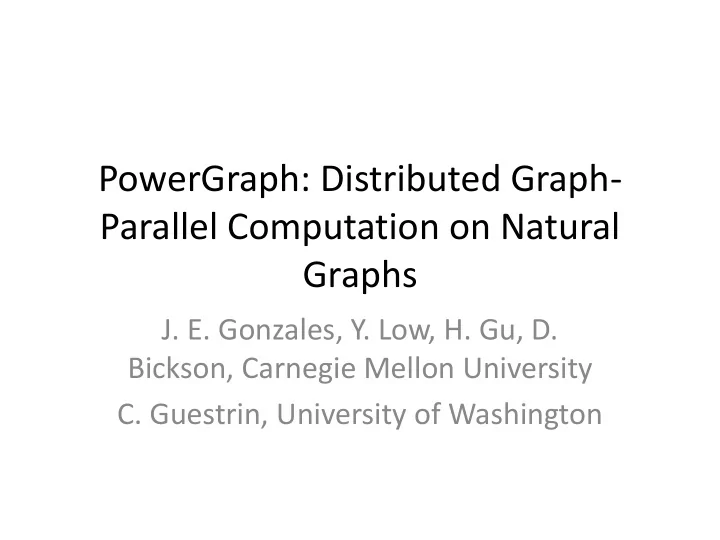

PowerGraph: Distributed Graph- Parallel Computation on Natural Graphs J. E. Gonzales, Y. Low, H. Gu, D. Bickson, Carnegie Mellon University C. Guestrin, University of Washington
Introduction • New framework for distributed graph paralleled computation on natural graphs • Transition from big data to big graphs
• Graphs are ubiquitous… • Graphs encode relationships between People Products Ideas Facts Interests Billions of vertices and edges and rich metadata
Graphs are essential for Data-Mining and Machine Learning • They help us identify influential people and information • Find communities • Target ads and products • Model complex data dependencies
Problem: Existing distributed graph computation systems perform poorly on Natural Graphs • Example: PageRank on Twitter Follower Graph 40M Users 1.4 Billion Links
Properties of the Natural Graphs
Challenges of Natural Graphs • Sparsity structure of natural graphs presents a unique challenge to efficient distributed graph-parallel computation • Hallmark property: most vertices have relatively few neighbours while a few have many neighbours
Properties of the Natural Graphs • Difficult to Partition – Power-Law graphs do not have low-cost balanced cuts – Traditional graph-partitioning algorithms perform poorly on Power-Law Graphs
PowerGraph • Split High-Degree vertices: • Introduction of new abstraction: EQUIVALENCE on Split Vertices
How do we program graph computation? • Graph-Parallel Abstraction – A user-defined Vertex-program runs on each vertex • Pregel – Graph constrains interact using messages • GraphLab – Graph constrains interact through shared state • Parallelism: run multiple vertex program at the same time
PageRank Algorithm • Example: The popularity of a user depends of the popularity of her followers, which depends of the popularity of their followers R i 0.15 w R j ji j Nbrs i ( ) Rank of user i Weighted sum of neighbors’ ranks • Update ranks in parallel • Iterate process until convergence
Pregel PageRank Receive all the Update the rank of messages the vertex Send new messages to neighbors
GraphLab PageRank Compute sum over neighbors Update the rank of the vertex
Challenges of High-Degree Vertices • A lot of iterating over our neighborhood • Pregel: many messages • GraphLab: Touches a large number of states
Pregel Message Combiners on Fan-IN • User defines commutative associative message operations:
Pregel Struggles with Fan-OUT • Fan-OUT: Broadcast sends many copies of the same message to the same machine
GraphLab Ghosting Changes to master are synced to ghosts
Fan-IN and Fan-Out performance More high-degree vertices
Graph Partitioning • Graph parallel abstractions rely on partitioning: – Minimize communication – Balance computation and storage • Both GraphLab and Pregel resort to random partitioning on natural graphs – They randomly split vertices over machines 10 Machines => 90% of edges cut 100 Machines => 99% of edges cut
In Summary • GraphLab and Pregel are not well suited for computation of natural graphs • Challenges of high-degree vertices • Low quality partitioning
Main idea of PowerGraph • GAS decomposition: distribute vertex – programs – Move computation to data – Parallelize high-degree vertices • Represents three conceptual phases of a vertex-program: – Gather – Apply – Scatter
PowerGraph Abstraction • Combines the best features from both Pregel and GraphLab – From GraphLab it borrows the data-graph and shared memory view of computation – From Pregel it borrows the commutative, associative gather concept
GAS Decomposition
PageRank in PowerGraph
Example
New Theorem: For any edge cut we can construct a vertex cut which requires strictly less communication and storage.
Constructing Vertex-Cuts • Evenly assign edges to machines – Minimize machines spanned by each vertex • Assign each edge as it is loaded – Touch each edge only once • Three distributed approaches: – Random Edge Placement – Coordinated Greedy Edge Placement – Oblivious Greedy Edge Placement
Random Edge Placement • Uniquely assigned to one machine • Balanced cut
Greedy Vertex-Cuts • Place edges on machines which already have the vertices in that edge. • If more machines have the same vertex, place edge on less loaded machine
Greedy Vertex-Cuts • Greedy minimizes the expected number of machines spanned • Coordinated – Requires coordination to place each edge – Slower: higher quality cuts • Oblivious – Approx. greedy objective without coordination – Faster: lower quality cuts
Partitioning Performance
Partitioning Performance
Other Features • Supports three execution modes: – Synchronous: Bulk-Synchronous GAS Phases – Asynchronous: Interleave GAS Phases – Asynchronous + Serializable: Neighbouring vertices do not run simultaneously • Delta Caching – Accelerate gather phase by caching partial sums for each vertex
Implementation and Evaluation • Technical details: – Experiments were performed on a 64 node cluster of Amazon EC2 Linux instances – Each instance has two quad core Intel Xeon X5570 processor with 23GB RAM and is connected via 10 GigE Ethernet – PowerGraph was written in C++ and compiled with GCC 4.5
System Design • Built on top of – MPI/TCP-IP – Pthreads – HDFS • Uses HDFS for Graph input and output • Fault-tolerance is achieved by check-poining – Snapshot time <5 sec. for twitter network
Implemented Algorithms
Results
More results
Thank you for your attention! http://graphlab.org Some of the slides were taken from the talk by J. E. Gonzalez, available on the website: https://www.usenix.org/conference/osdi12/ technical-sessions/presentation/gonzalez
Recommend
More recommend